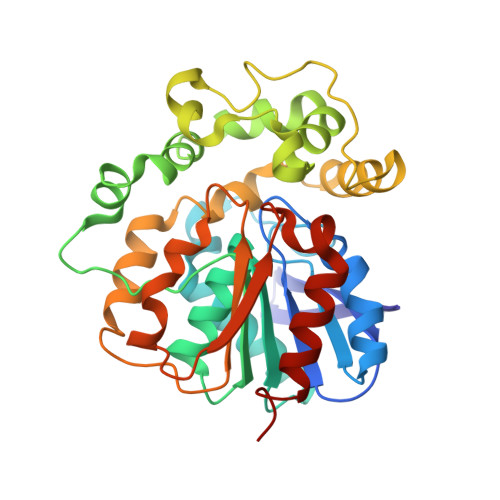Discovery of 1-(1,3,5-triazin-2-yl)piperidine-4-carboxamides as inhibitors of soluble epoxide hydrolase.
Thalji, R.K., McAtee, J.J., Belyanskaya, S., Brandt, M., Brown, G.D., Costell, M.H., Ding, Y., Dodson, J.W., Eisennagel, S.H., Fries, R.E., Gross, J.W., Harpel, M.R., Holt, D.A., Israel, D.I., Jolivette, L.J., Krosky, D., Li, H., Lu, Q., Mandichak, T., Roethke, T., Schnackenberg, C.G., Schwartz, B., Shewchuk, L.M., Xie, W., Behm, D.J., Douglas, S.A., Shaw, A.L., Marino, J.P.(2013) Bioorg Med Chem Lett 23: 3584-3588
- PubMed: 23664879
- DOI: https://doi.org/10.1016/j.bmcl.2013.04.019
- Primary Citation of Related Structures:
4JNC - PubMed Abstract:
1-(1,3,5-Triazin-yl)piperidine-4-carboxamide inhibitors of soluble epoxide hydrolase were identified from high through-put screening using encoded library technology. The triazine heterocycle proved to be a critical functional group, essential for high potency and P450 selectivity. Phenyl group substitution was important for reducing clearance, and establishing good oral exposure. Based on this lead optimization work, 1-[4-methyl-6-(methylamino)-1,3,5-triazin-2-yl]-N-{[[4-bromo-2-(trifluoromethoxy)]-phenyl]methyl}-4-piperidinecarboxamide (27) was identified as a useful tool compound for in vivo investigation. Robust effects on a serum biomarker, 9, 10-epoxyoctadec-12(Z)-enoic acid (the epoxide derived from linoleic acid) were observed, which provided evidence of robust in vivo target engagement and the suitability of 27 as a tool compound for study in various disease models.
- Department of Chemistry, Heart Failure Disease Performance Unit, Metabolic Pathways and Cardiovascular Therapeutic Area Unit, GlaxoSmithKline, 709 Swedeland Road, King of Prussia, PA 19406, USA.
Organizational Affiliation:

















